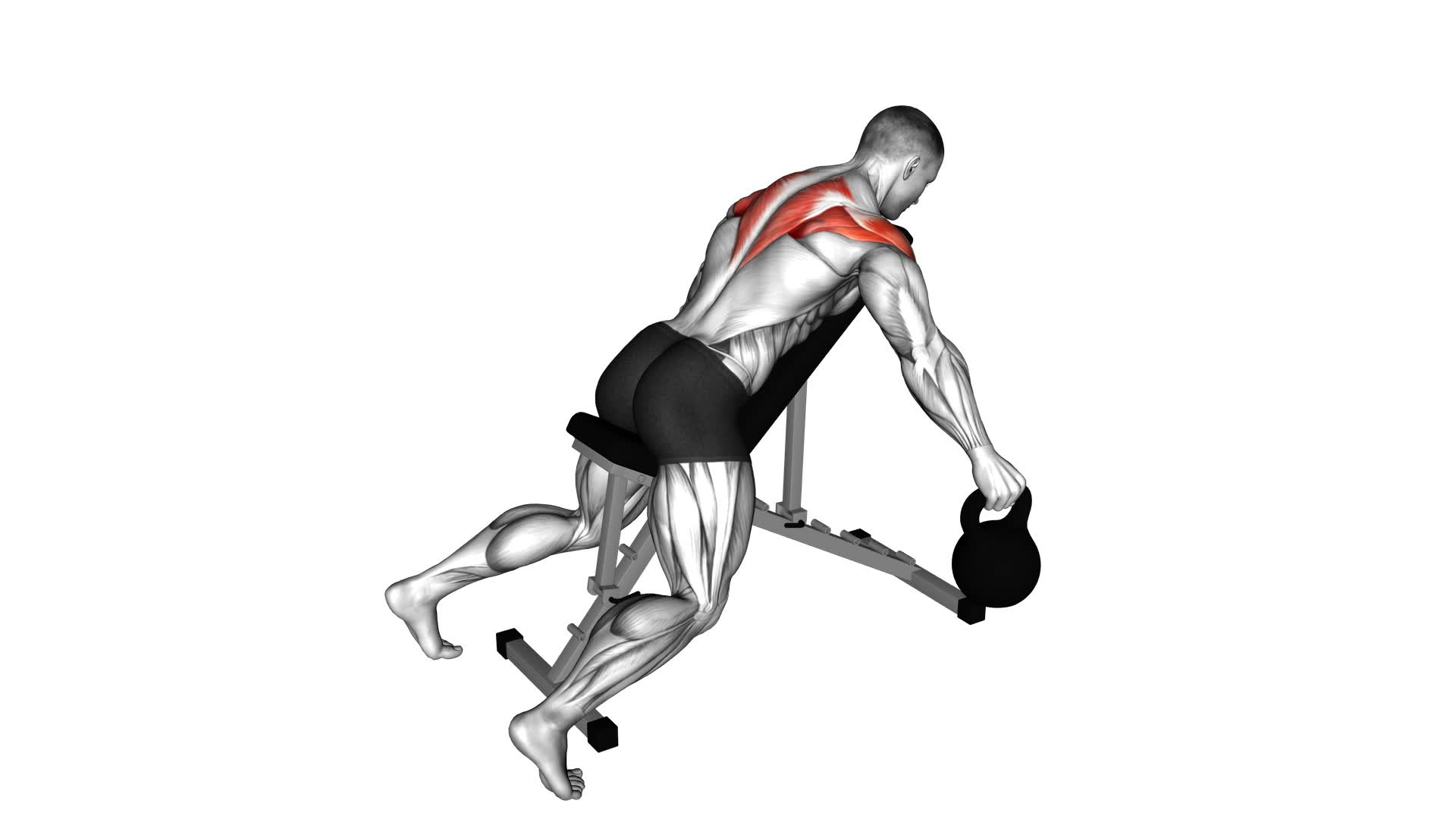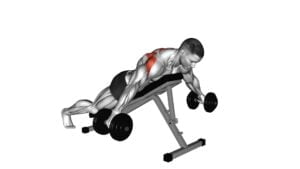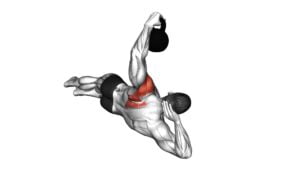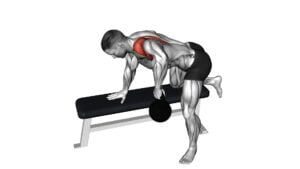Kettlebell Prone Rear Delt Swing – Video Exercise Guide & Tips

Are you looking for a challenging exercise to target your rear deltoids? Look no further than the Kettlebell Prone Rear Delt Swing.
Watch This Exercise Video
In this video exercise guide, we'll show you the proper technique and form for this effective move.
Discover the benefits, equipment needed, common mistakes to avoid, and tips for increasing intensity.
Get ready to strengthen and tone your rear delts with this dynamic kettlebell exercise.
Let's dive in and get started!
Key Takeaways
- Targets rear deltoid muscles
- Enhances shoulder strength and stability
- Improves posture
- Reduces the risk of shoulder injuries
Benefits of the Kettlebell Prone Rear Delt Swing
The kettlebell prone rear delt swing offers several benefits for your upper body strength and shoulder stability. This exercise specifically targets the rear deltoid muscles, which are often neglected in traditional shoulder exercises. By incorporating this movement into your workout routine, you can enhance your overall shoulder strength and stability.
One of the main benefits of shoulder exercises, including variations of rear delt exercises like the kettlebell prone rear delt swing, is improved posture. Strong rear deltoid muscles help to pull your shoulders back, counteracting the effects of slouching and rounded shoulders. This can help you maintain a more upright and confident posture throughout the day.
Additionally, the kettlebell prone rear delt swing helps to improve shoulder stability. By strengthening the muscles that support the shoulder joint, you can reduce the risk of injuries and enhance your overall functional fitness. This is particularly important for athletes and individuals who engage in activities that require overhead movements, such as throwing, swimming, or weightlifting.
As we transition into the subsequent section about the equipment needed for the exercise, it's important to note that the kettlebell prone rear delt swing can be performed with just a kettlebell. This makes it a convenient and accessible exercise that you can incorporate into your routine, regardless of your fitness level or access to equipment.
Equipment Needed for the Exercise
To perform the Kettlebell Prone Rear Delt Swing, you'll need a kettlebell and a flat surface to lie on. The kettlebell should be a weight that challenges you but allows you to maintain proper form throughout the exercise.
If you don't have access to a kettlebell, you can use a dumbbell or even a water bottle filled with sand or rocks as an alternative.
Essential Equipment for Exercise
You'll need a kettlebell for this exercise's equipment.
Here are some essential exercise equipment and workout gear that can enhance your fitness routine:
- Comfortable workout clothes: Wearing breathable, flexible clothing will help you move freely during your workout and prevent any discomfort.
- Athletic shoes: Invest in a good pair of supportive athletic shoes that fit properly to provide stability and prevent injuries.
- Exercise mat: A non-slip exercise mat will provide cushioning and support for floor exercises, making your workout more comfortable.
- Water bottle: Staying hydrated is crucial during exercise, so make sure to have a water bottle nearby to quench your thirst.
Having the right exercise equipment and workout gear can make a significant difference in your fitness journey. It ensures your comfort, safety, and overall enjoyment of your workout sessions.
Alternatives to Required Equipment
If you don't have a kettlebell, there are alternative equipment options you can use for this exercise. One option is to perform bodyweight exercises that target the same muscle group. For the kettlebell prone rear delt swing, you can try exercises like prone rear delt raises or prone T raises. These exercises involve lying face down on the floor and lifting your arms out to the sides or in a T shape. These bodyweight exercises can help strengthen your rear deltoids without the need for any additional equipment.
Another alternative is to use resistance bands. You can attach the bands to a sturdy anchor point and perform exercises like band pull-aparts or standing rear delt pulls. These exercises provide resistance to target and strengthen your rear deltoids.
Experiment with different bodyweight exercises and resistance band exercises to find what works best for you.
Proper Technique and Form for the Swing
To perform the kettlebell swing with proper technique and form, there are a few key points to keep in mind.
First, focus on the hip hinge movement, allowing your hips to drive the motion while keeping your back straight.
Engage your core and glutes throughout the exercise to maintain stability and maximize power.
Additionally, make sure to use a proper hand grip on the kettlebell to ensure control and prevent any accidents.
Hip Hinge Movement
Master the hip hinge movement to ensure proper technique and form for the swing. The hip hinge is a fundamental movement pattern that involves activating the glutes and using proper hip hinge mechanics. By mastering the hip hinge, you won't only improve your kettlebell swing, but also enhance your overall athletic performance.
Here are four key points to remember when performing the hip hinge movement:
- Engage your glutes: Focus on squeezing your glutes throughout the movement to maximize glute activation and power.
- Maintain a neutral spine: Keep your back straight and avoid rounding or arching your back to protect your spine.
- Initiate the movement from your hips: Hinge at the hips, pushing them back as you lower your torso, rather than bending at the waist.
- Keep your knees slightly bent: Avoid locking out your knees and maintain a slight bend to provide stability and prevent strain on your joints.
Core and Glute Engagement
To ensure proper technique and form for the swing, it's crucial that you engage your core and glutes throughout the movement. Core stability is essential for maintaining a strong and stable base, allowing you to generate power and control during the exercise. By activating your glutes, you ensure that the movement is initiated from the hips, rather than relying on your lower back or arms.
To engage your core, focus on pulling your belly button towards your spine and maintaining a neutral spine position throughout the swing. This will help protect your lower back and improve overall stability. By activating both your core and glutes, you'll enhance your performance and prevent injury during the kettlebell swing.
Now that you understand the importance of core and glute engagement, let's move on to discussing the proper hand grip.
Proper Hand Grip
When gripping the kettlebell for the prone rear delt swing, ensure that your hand is firmly wrapped around the handle. Proper hand position and finger placement are crucial for maintaining control and maximizing the effectiveness of the exercise. Here are some key tips to remember:
- Hold the kettlebell handle with an overhand grip, wrapping your fingers around it.
- Keep your fingers relaxed, but maintain a firm grip to prevent the kettlebell from slipping.
- Place your thumb on the same side as your fingers, ensuring it's securely wrapped around the handle.
- Avoid gripping the handle too tightly, as it can lead to unnecessary tension in the forearm muscles.
By following these guidelines, you'll have a strong and secure grip, allowing you to execute the prone rear delt swing with proper technique and form.
Now, let's move on to the next section and discuss common mistakes to avoid.
Common Mistakes to Avoid
You should avoid making these common mistakes when performing the kettlebell prone rear delt swing.
One common mistake is using too heavy of a weight. It's important to start with a weight that you can control and gradually increase the weight as your strength and technique improve.
Another mistake is using improper technique. Make sure to keep your core engaged and your back flat throughout the movement. Avoid arching your back or rounding your shoulders.
Additionally, don't swing the kettlebell too high or use momentum to lift the weight. The movement should be controlled and focused on targeting the rear delts.
Lastly, avoid rushing through the exercise. Take your time and focus on each repetition to ensure proper form and maximum effectiveness.
By avoiding these common mistakes, you can perform the kettlebell prone rear delt swing safely and effectively.
Now, let's move on to some tips for increasing intensity and difficulty.
Tips for Increasing Intensity and Difficulty
To increase the intensity and difficulty of the kettlebell prone rear delt swing, incorporate progressive overload by gradually increasing the weight used. This will challenge your muscles and help you make progress in your fitness journey.
Here are some tips to help you increase the resistance and modify the exercises:
- Increase the weight: Gradually add more weight to the kettlebell as you become stronger. This will provide a greater challenge to your rear deltoids and help you build more muscle.
- Perform more repetitions: Instead of increasing the weight, you can also increase the number of repetitions you perform during each set. This will help fatigue your muscles and promote growth.
- Modify the exercise position: You can experiment with different positions to target your rear deltoids from different angles. For example, you can try performing the exercise while lying on an incline bench or on a stability ball.
- Use tempo variations: Varying the tempo of your repetitions can also increase the difficulty of the exercise. You can try slowing down the lowering phase or pausing at the top of the movement to challenge your muscles further.
By incorporating these tips, you can effectively increase the intensity and difficulty of the kettlebell prone rear delt swing.
Now let's move on to the next section to learn a sample workout routine using this exercise.
Sample Workout Routine Using the Kettlebell Prone Rear Delt Swing
To incorporate the kettlebell prone rear delt swing into your workout routine, continue building intensity and difficulty by implementing these strategies.
Start with a warm-up to prepare your muscles for the workout. This can include exercises like arm circles and shoulder rolls. Once you're warmed up, begin with a set of 10 to 12 reps of the kettlebell prone rear delt swing. Focus on maintaining proper form and engaging your rear deltoids throughout the movement.
To add variation to your workout, you can try different kettlebell weights or perform the exercise on an unstable surface, like a BOSU ball. This will challenge your stability and activate more muscles in your core.
To further engage your rear delts, you can also incorporate other exercises that target this muscle group, such as bent-over lateral raises or reverse flyes. These exercises can be performed using dumbbells or resistance bands.
Remember to listen to your body and adjust the intensity and difficulty of the workout as needed. It's important to gradually increase the weight and repetitions over time to continue challenging your muscles and promoting growth.
Frequently Asked Questions
How Many Calories Can You Burn With the Kettlebell Prone Rear Delt Swing?
You can burn a significant number of calories with the kettlebell prone rear delt swing. This exercise technique targets your rear deltoid muscles, helping to strengthen and tone them.
By engaging multiple muscle groups and increasing your heart rate, you can maximize calorie burn during this exercise.
It's a great way to add variety to your workout routine and torch calories in the process.
Can the Kettlebell Prone Rear Delt Swing Help With Shoulder Mobility and Flexibility?
The kettlebell prone rear delt swing can be beneficial for improving shoulder mobility and flexibility. This exercise specifically targets the rear delts, which are important for shoulder stability and range of motion.
By incorporating this movement into your routine, you can help strengthen and stretch the muscles surrounding your shoulder joint, leading to increased mobility and flexibility.
It's important to maintain proper form and start with lighter weights to prevent injury and gradually increase as you get stronger.
Is It Safe to Perform the Kettlebell Prone Rear Delt Swing if You Have a History of Shoulder Injuries?
If you have a history of shoulder injuries, it may not be safe to perform the kettlebell prone rear delt swing. It's important to prioritize shoulder injury prevention and avoid exercises that could aggravate your condition.
Instead, consider alternative exercises that focus on strengthening the rear deltoids without putting excessive strain on the shoulder joint. Consult with a healthcare professional or a qualified trainer for personalized recommendations based on your specific condition.
Can the Kettlebell Prone Rear Delt Swing Be Modified for Beginners or Individuals With Limited Strength?
Modified variations of the kettlebell prone rear delt swing can be done for beginners or individuals with limited strength. These variations allow you to gradually build your upper body strength while reducing the risk of injury.
By starting with lighter kettlebells or using bodyweight exercises, you can focus on proper form and technique before progressing to heavier weights.
This exercise is great for targeting the muscles in your upper back, shoulders, and arms, helping to improve overall upper body strength.
How Often Should You Incorporate the Kettlebell Prone Rear Delt Swing Into Your Workout Routine for Optimal Results?
To get optimal results from the Kettlebell Prone Rear Delt Swing, you need to consider your workout frequency and exercise intensity. Incorporating this exercise into your routine regularly can help improve your rear deltoid muscles.
However, it's important to balance it with other exercises and give your muscles time to recover. Aim for 2-3 sessions per week, and gradually increase the intensity as your strength improves.
Remember to listen to your body and adjust as needed.
Conclusion
In conclusion, the kettlebell prone rear delt swing is a highly effective exercise for targeting the rear deltoid muscles. By using proper technique and form, individuals can benefit from increased shoulder strength and stability.
It's important to avoid common mistakes and gradually increase intensity to avoid injury. By incorporating the kettlebell prone rear delt swing into a workout routine, individuals can achieve stronger and more defined rear deltoids.

Author
Years ago, the spark of my life’s passion ignited in my mind the moment I stepped into the local gym for the first time. The inaugural bead of perspiration, the initial endeavor, the very first surge of endorphins, and a sense of pride that washed over me post-workout marked the beginning of my deep-seated interest in strength sports, fitness, and sports nutrition. This very curiosity blossomed rapidly into a profound fascination, propelling me to earn a Master’s degree in Physical Education from the Academy of Physical Education in Krakow, followed by a Sports Manager diploma from the Jagiellonian University. My journey of growth led me to gain more specialized qualifications, such as being a certified personal trainer with a focus on sports dietetics, a lifeguard, and an instructor for wellness and corrective gymnastics. Theoretical knowledge paired seamlessly with practical experience, reinforcing my belief that the transformation of individuals under my guidance was also a reflection of my personal growth. This belief holds true even today. Each day, I strive to push the boundaries and explore new realms. These realms gently elevate me to greater heights. The unique combination of passion for my field and the continuous quest for growth fuels my drive to break new ground.



